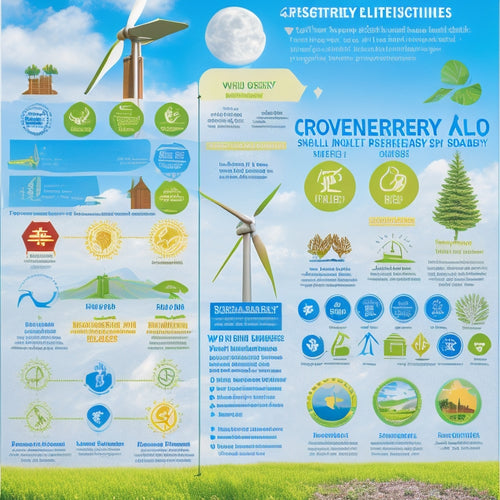Wearable Sustainability: Eco-Friendly Maintenance for Your Accessories
Share
As you take a closer look at your accessories, you might wonder if there's a better way to care for them without harming the planet. You're not alone. The way you clean, condition, and store your accessories can have a substantial impact on the environment. By making a few simple changes, you can reduce your ecological footprint and extend the life of your accessories. But where do you start? From natural cleaning alternatives to upcycling old favorites, there are many ways to adopt wearable sustainability. Let's explore the possibilities – and start with the small changes that can make a big difference.
Key Takeaways
• Adopt eco-friendly cleaning methods for accessories, swapping harsh chemicals for natural ingredients and essential oils with antibacterial properties.
• Choose sustainable storage options for jewelry, repurposing vintage displays or using eco-friendly materials like recycled wood or upcycled fabric.
• Opt for green alternatives for polishing accessories, using eco coatings, plant wax, and microfiber cloths to avoid harsh chemicals.
• Practice energy-efficient accessory care by switching to solar chargers, turning off devices when not in use, and unplugging chargers to eliminate standby power consumption.
• Give old accessories a second life through creative upcycling, reducing waste and preserving sentimental value while expressing personal style.
Cleaning With Natural Ingredients
As you explore the world of eco-friendly maintenance, start by swapping harsh chemical-laden cleaners for natural ingredients that gently yet effectively clean your accessories. This shift not only benefits the environment but also safeguards your valuable possessions from damage.
Essential oils, renowned for their antibacterial and antifungal properties, can be used to craft potent cleaning solutions. Tea tree oil, for instance, is exceptional at tackling tough stains and odors. When blended with fruit extracts, such as lemon or orange, these oils create a powerful yet gentle cleaning agent.
To create your own natural cleaner, mix a few drops of essential oil with a tablespoon of fruit extract and a cup of water. Apply the solution to a soft cloth, gently wipe down your accessories, and witness the remarkable cleaning power of nature.
Sustainable Leather Conditioning
By conditioning your leather accessories with sustainable methods, you'll not only preserve their suppleness and prevent cracks, but also reduce your reliance on chemical-based products that harm the environment. When it comes to sustainable leather conditioning, it's essential to consider the entire supply chain, from leather sourcing to the final product.
Look for brands that prioritize eco-friendly practices, such as using recycled materials, minimizing waste, and ensuring fair labor practices.
When choosing a leather conditioner, opt for natural ingredients like beeswax, coconut oil, or shea butter. These ingredients not only nourish the leather but also reduce the amount of harsh chemicals released into the environment.
Be mindful of the packaging too - choose conditioners with minimal, recyclable, or biodegradable packaging to minimize waste. By taking these steps, you'll not only extend the life of your leather accessories but also contribute to a more sustainable future.
Water Conservation in Care
As you care for your accessories, remember that water conservation is key to reducing your environmental footprint.
You can start making a difference by adopting simple habits, like rinsing your accessories with care and washing them by hand only when necessary.
Rinse With Care Always
When washing your accessories, you're not just removing dirt and grime, you're also making a significant impact on the environment, and that's why it's important to rinse with care always.
Every time you wash your accessories, you're using precious resources like water and energy. That's why it's necessary to be mindful of your washing habits. Start by selecting a gentle cycle that's designed for delicate items. This won't only preserve the quality of your accessories but also reduce the amount of water and energy consumed.
Another critical aspect of rinsing with care is soap selection. Opt for eco-friendly soaps that are free from harsh chemicals and toxins. These soaps are gentle on your accessories and the environment.
Remember, every small change you make to your washing habits can have a significant impact on the planet. By rinsing with care, you're taking an important step towards reducing your carbon footprint and promoting sustainability.
Wash by Hand Only
You can greatly reduce your water consumption by washing your accessories by hand, a simple yet effective way to conserve this precious resource. By skipping the gentle cycles of your washing machine, you'll not only save water but also prevent unnecessary wear and tear on your accessories.
When washing by hand, it's essential to select a mild soap that's specifically designed for delicate items. Avoid harsh chemicals that can damage or discolor your accessories. Instead, opt for a soap that's gentle on fabrics and the environment.
When washing, use lukewarm water and a soft-bristled brush to gently scrub away any dirt or stains. Rinse your accessories thoroughly to remove any soap residue, and then gently squeeze out excess water.
Conserve Water Now
By adopting hand washing as your go-to method, you're already taking a significant step towards conserving water, and now it's time to explore more ways to reduce your water footprint in accessory care. Water conservation is vital, as the fashion industry is one of the largest consumers of water globally. Every drop counts, and it's important to take control of your water usage.
Here are three ways to conserve water in accessory care:
-
Fix Leaks: A single dripping faucet can waste up to 20 gallons of water per day. Inspect your sink and pipes for any leaks and fix them promptly.
-
Use a Water-Efficient Sink: Install a low-flow faucet or aerator to reduce water flow while maintaining pressure. This simple switch can save up to 2.5 gallons of water per minute.
-
Rinse Wisely: Use a rinse cup or a container to catch excess water, and reuse it for future washing or other purposes. Every gallon counts in aquatic conservation.
DIY Accessory Repair Hacks
As you take matters into your own hands, you'll find that repairing your accessories isn't as intimidating as it seems. With a few simple tricks up your sleeve, you can breathe new life into your beloved belongings and reduce waste in the process.
Fix It Yourself
With a little creativity and some basic tools, broken accessories can be revived, and their lifespan extended, reducing the need for frequent replacements and the environmental harm that comes with them. By taking matters into your own hands, you're not only saving money but also contributing to a more sustainable future.
Here are three reasons why DIY accessory repair is a game-changer:
-
Empowerment: You'll develop a sense of accomplishment and confidence in your ability to fix things, rather than relying on others.
-
Cost-effective: Repairing your accessories instead of replacing them can save you a significant amount of money in the long run.
-
Environmental impact: By extending the life of your accessories, you're reducing the demand for new, resource-intensive products and the waste that comes with them.
To get started, organize your tools and workspace, and begin building your repair skills. With practice, you'll become more efficient and confident in your ability to fix your accessories. Remember, every small step counts, and by taking control of your accessory maintenance, you're contributing to a more sustainable future.
Easy Repair Tricks
You'll be amazed at how a few simple tricks can breathe new life into your broken accessories, from reviving dead batteries to loosening stuck zippers. With a few DIY repair hacks, you can rescue your favorite pieces from the landfill and reduce waste.
For a zipper rescue, try applying a small amount of lip balm or silicone spray to the teeth. This will help the zipper glide smoothly again.
If a button is loose, use a toothpick to apply a tiny dot of clear nail polish to the thread, securing it in place. This button revival trick is a game-changer!
When dealing with tarnished metal, mix baking soda and water to form a paste. Apply it to the affected area and let it sit before rinsing with warm water. This eco-friendly cleaning hack will leave your accessories shining like new.
The Impact of Microbeads
Microbeads, those tiny plastic particles found in many personal care products, have been contaminating our waterways and harming aquatic life at an alarming rate of over 8 trillion per day. You might be thinking, 'What's the big deal? They're just tiny particles!' But the reality is, microbeads are having a devastating impact on our environment. They're ingested by fish and other marine animals, which can lead to physical harm and even death.
Here are just a few alarming facts to contemplate:
-
Microbeads are consumed by humans: When microbeads enter our waterways, they're eventually consumed by humans through the food chain.
-
Microbeads harm marine life: Microbeads can cause physical harm and even death to marine animals who ingest them.
-
Microbeads contaminate soil and water: Microbeads can accumulate in soil and water, leading to long-term environmental damage.
Fortunately, there's hope. Microbead Legislation and Environmental Research are working to combat this issue. As consumers, you have the power to make a change. By choosing microbead-free products and supporting eco-friendly brands, you can help reduce the devastating impact of microbeads on our environment.
Eco-Friendly Jewelry Storage
Your jewelry collection deserves a storage solution that's as stylish as it's sustainable, and opting for eco-friendly jewelry storage can make a significant difference in reducing waste and preserving our planet's resources.
By choosing sustainable storage options, you're not only protecting your jewelry but also the environment.
Consider repurposing vintage displays or opting for minimalist cases crafted from eco-friendly materials. These options not only reduce waste but also add a touch of elegance to your jewelry collection.
Look for storage solutions made from recycled materials, such as recycled wood or upcycled fabric. You can also get creative and DIY your own jewelry storage using materials you already have at home.
Green Alternatives to Polishing
Three quarters of jewelry polishing products contain harsh chemicals that harm the environment, making it essential to explore green alternatives to keep your accessories shining.
You can make a difference by choosing eco-friendly polishing methods that don't compromise on sparkle.
Here are three game-changing alternatives to traditional polishing:
-
Eco Coatings: A water-based, non-toxic solution that leaves your jewelry looking radiant without harming the planet.
-
Plant Wax: A natural, biodegradable wax derived from plants, providing a gentle and effective polishing experience.
-
Microfiber Cloths: Soft, reusable cloths that remove tarnish and grime without the need for harsh chemicals.
Energy-Efficient Accessory Care
By adopting energy-efficient care habits, you can greatly reduce your carbon footprint and keep your accessories looking their best without draining the planet's resources. One of the simplest ways to make a positive impact is to switch to energy-efficient charging methods. Consider investing in solar chargers or power savers that can greatly reduce your energy consumption.
Here are some energy-efficient care tips to get you started:
| Energy-Efficient Tip | Benefits |
|---|---|
| Use solar chargers | Reduces reliance on non-renewable energy sources |
| Turn off devices when not in use | Saves energy and prolongs device lifespan |
| Invest in power savers | Reduces standby power consumption |
| Unplug chargers when not in use | Eliminates standby power consumption |
| Choose energy-efficient accessories | Supports sustainable manufacturing practices |
Upcycling Old Accessories Creatively
Now that you've optimized your accessory care routine for energy efficiency, it's time to breathe new life into old favorites by upcycling them creatively. Upcycling is an art form that not only reduces waste but also gives you a sense of pride and accomplishment. Imagine transforming an old, worn-out handbag into a trendy tote or turning a vintage brooch into a statement piece. The possibilities are endless, and the best part is that you get to give your accessories a second chance at life.
Here are three reasons why upcycling your old accessories is a game-changer:
-
Reduce waste: By upcycling, you're diverting waste from landfills and reducing the demand for new, resource-intensive materials.
-
Get creative: Upcycling allows you to express your personal style and creativity, making each piece truly unique.
-
Preserve memories: By revamping old accessories, you're preserving memories and sentimental value, giving new life to pieces that hold emotional significance.
Through upcycling, you can achieve an Accessory Revamp that's both sustainable and stylish. Whether it's Vintage Restyling or creating something entirely new, the possibilities are endless.
Frequently Asked Questions
Can I Use Essential Oils to Repel Pests From My Accessories?
You can harness the power of natural deterrents by using essential oils to repel pests from your accessories, creating scented storage solutions that keep critters at bay while keeping your belongings fresh and fragrant.
How Often Should I Condition My Sustainable Leather Accessories?
"You should condition your sustainable leather accessories every 2-3 months to prevent leather aging, ensuring they remain supple and vibrant; this frequency will maintain their quality and extend their lifespan."
Are There Eco-Friendly Alternatives to Fabric Softener for Cleaning Fabrics?
You're seeking eco-friendly alternatives to fabric softener for cleaning fabrics! Opt for natural detergents and explore Green refills that reduce waste, ensuring a gentler impact on the environment while keeping your fabrics fresh and clean.
Can I Recycle Old or Broken Accessories to Reduce Waste?
You can recycle old or broken accessories, reducing waste and supporting a circular economy. Donate still-usable items to local charities or repurpose materials for creative projects, embracing Accessory Donation and Material Reuse.
Do Eco-Friendly Jewelry Cleaning Products Expire or Go Bad?
When you're shopping for eco-friendly jewelry cleaning products, make sure to check the product labeling for shelf life or expiration dates to guarantee you're getting the most effective clean without harming the planet or your accessories.
Related Posts
-

Home Solar Systems for Environmental Impact
Home solar systems markedly reduce your carbon footprint by utilizing renewable energy. By adopting solar energy, you...
-

Renewable Energy Certifications for Businesses
Renewable energy certifications are essential for your business, showcasing your commitment to sustainability and enh...
-

Energy-Efficient Heating and Cooling Appliances
Energy-efficient heating and cooling appliances can cut your energy bills markedly. By opting for models with high En...


